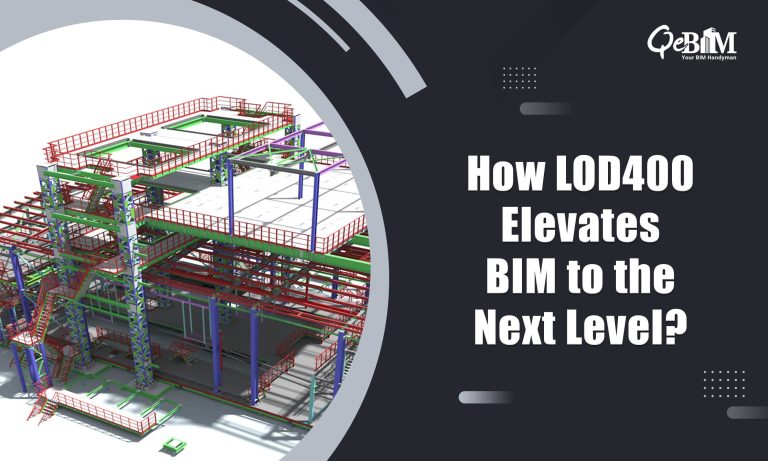How LOD400 Elevates BIM to the Next Level?

In the rapidly evolving world of BIM, understanding the various Levels of Development (LOD) is crucial for the AEC professionals who are aiming to leverage the BIM Modeling Services to its fullest potential. Among these levels, LOD400 stands out as a pivotal stage that significantly impacts design as well as virtual construction. This blog post delves into why LOD400 is essential and how it enhances the accuracy and efficiency of modern construction projects.
What is LOD400?
Level of Development (LOD) is a framework that is used to define the completeness and reliability of a BIM model at the various stages of a project. The LOD system ranges from LOD100 to LOD500. Each of level represents a different stage of development, detail, as well as accuracy. Specifically, LOD400, also known as the “Fabrication” level, is characterized by its focus on detailed and precise information necessary for construction and fabrication.
At LOD400, a BIM model includes the detailed as well as the accurate information that reflects the actual components used in the construction process. This level goes beyond mere representations and encompasses detailed dimensions, materials, along with the installation information that are crucial for the execution phase.
Why LOD400 Matters?
1) Enhanced Accuracy and Detail
One of the most important advantages of LOD400 is its ability to provide a high degree of accuracy and detail. At this stage, the models include precise dimensions and specifications of building components which are proven to be essential for the fabrication as well as the construction. This level of detail reduces the risk of errors and discrepancies during construction thereby leading to a more predictable and efficient project execution.
2) Improved Coordination and Clash Detection
With LOD400, the detailed model allows for better coordination among different trades and disciplines. Accurate representations of structural elements, mechanical systems as well as the architectural components helps to identify and resolve the potential clashes/conflicts before they manifest on the construction site. This proactive method for identifying and resolving clashes minimizes costly rework and delays ultimately ensuring more smoother project execution.
3) Streamlined Fabrication and Construction
LOD400 model provides the detailed information needed for the fabrication of components along with the assemblies. This includes precise measurements, material specifications as well as the installation details. By using these detailed models, the fabricators can create components that fit perfectly with the intended design thereby reducing the need for adjustments and modifications on-site. This level of detail also facilitates the use of automated machinery and prefabrication techniques further enhancing the efficiency and reducing the construction timeline.
4) Enhanced Project Visualization
At LOD400, the BIM model offers a high level of realism which improves project visualization. The stakeholders can better understand the final appearance along with the functionality of the project thereby making it easier to communicate the design intent and make informed decisions. This enhanced visualization can also aid in presentations and client approvals leading to a smoother project progression.
5) Accurate Cost Estimation and Scheduling
The detailed information provided at the LOD400 is instrumental in developing accurate cost estimates and project schedules. With precise data on materials, quantities as well as the installation requirements, it becomes easier for the project managers and cost estimators to produce more reliable cost forecasts along with schedules. This level of detail helps in budgeting more effectively as well as managing the resources more efficiently thereby contributing to the overall success of the project.
6) Facilitates Integration with Construction Technology
The LOD400 models are well-suited for the integration with various construction technologies like Building Robotics, Augmented Reality (AR) as well as the Virtual Reality (VR). The detailed and accurate information in these models allows for the seamless use of the advanced construction technologies thereby leading to a more innovative yet efficient construction practices.
Challenges and Considerations
While LOD400 offers numerous benefits, achieving this level of detail requires careful consideration and planning. The creation of LOD400 models demands significant time and resources as well as expertise in model development and data management. It is essential for the project teams to balance the need for detail with the associated costs and effort.
Additionally, ensuring that all stakeholders are aligned with the LOD400 requirements is also crucial for maximizing the benefits of this level of development.
Conclusion
LOD400 represents a critical milestone in the BIM process. It provides the detailed and accurate information needed for the successful fabrication as well as the construction and is of utmost importance in Shop Drawing Services. Its impact on accuracy, coordination, visualization, cost estimation along with technology integration makes it an indispensable aspect of the modern construction projects. By embracing LOD400 and leveraging its benefits will you can achieve greater efficiency, accuracy and success in the design as well as the construction process.